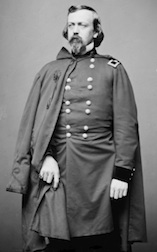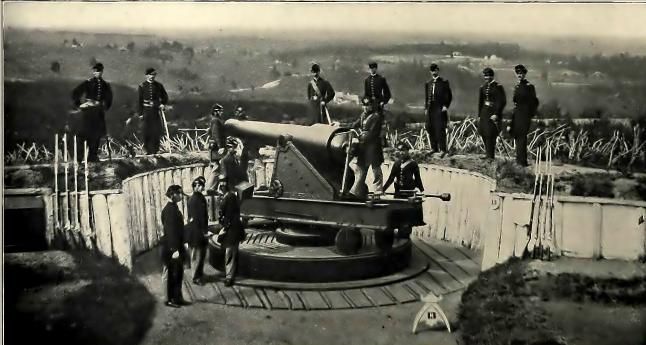The Origins of Fortress Washington

Emerging Civil War welcomes guest author Steve T. Phan
By 1865, Washington D.C. was surrounded. On the high hills, long ridges, and flat plateaus that encircled the capital of the United States was an elaborate system of fortifications. Now, as the Civil War approached its bloody conclusion, 68 major forts supported by 93 detached batteries mounting over 900 guns and connected by 32 miles of military roads made Washington one of the most heavily fortified cities in the world.
However, just four years prior, as the Union teetered on the edge of dissolution, one obsolete defensive position (Fort Washington, 11 miles south of the city on the Potomac River) manned by a single ordnance sergeant and a small company of Marines protected the city.
War altered the capital’s landscape. Prior to the conflict, the city was a temporary way-station for government officials, congressmen, clerks, and their families. A mere 62,000 people resided in the area in 1860, a population ranking 12th among American cities. This number tripled during the Civil War as tens of thousands of soldiers, government employees, merchants, contractors, freedmen and others descended on the capital. Washington D.C. may have been the political epicenter of the young country, the beacon that attracted representatives from across the country, but its soul was anything but bipartisan.
The city reflected the influences of the Southern states on its border: Maryland and Virginia. As Margaret Leech noted in her Pulitzer winning work, Reveille in Washington, 1860-1865 (1941), if the two slave states “were both to succeed, they would carry Washington with them. Sympathy with secession was strong in large groups of the city’s residents, and it was feared that they would participate in any seditious enterprise.”[1] The Federal government, especially the War Department, was keenly aware of the genuine threats residing within the city and surrounding states. Non-aggressive but visible steps were taken that demonstrated the government’s resolve and desire to maintain peace. But for the moment, caution and compromise was the battle cry as the country awaited the outcome of the presidential election of 1860. Its outcome threatened to split the country into two; citizens throughout the Union looked toward Washington for strength and guidance. The city’s pre-war function as the transient national government city transformed into the symbolic sword and symbol of the United States as the secession crises turned hot.

The defense of Washington evolved over time. The first iteration occurred months prior to armed hostilities, involved uniformed soldiers as the frontline barriers, and was overseen by the country’s most experienced and revered officer. Less than a month after the election, outgoing President James Buchanan recalled Brevet Lieutenant General Winfield Scott from New York City to Washington. The aging commanding general of the U.S. Army arrived ten days later, taking residence at the Windsor Building, one block west of the White House.
Scott’s responsibilities, beyond the immense task of running the army, was “to supervise Washington’s defensive measures in the waning days of the Buchanan administration and the expected trouble at” newly elected Abraham Lincoln’s inauguration.[2] Scott responded to his new duties with dutiful energy and competence. He immediately called upon and recommissioned former army officer Charles P. Stone as inspector general of the District of Colombia Militia with the rank of colonel. In accordance to his orders to secure the city, Stone secured roads, bridges, and key avenues of approach to the city with soldiers.

In case of an attack, Stone planned a defense that centered on the Federal government’s stone infrastructure. Three strategic centers—the Capitol, Old City Hall, including the Patent Office, and the Executive Square (War, Navy, State, and Treasury Departments)—were supplied with 2,000 barrels of flour and fresh water, enough to survive a siege of ten days, and companies of soldiers to defend the citadels long enough for the Regular Army to reinforce the city. Despite the preemptive measures, the threat against Washington intensified as secession shattered the Union’s accord. South Carolina seceded by the end of 1860 followed by Mississippi, Florida, Alabama, Georgia, Louisiana, and Texas. The formation the Confederate States of America in February 1861 occurred just three weeks prior to president-elect Lincoln’s official arrival to Washington.
General Scott responded accordingly. The district’s militia needed substantial reinforcements. Eight companies of U.S. Regulars were ordered to the city and directed to guard strategic locations. Artillery pieces lined busy avenues and squadrons of cavalry patrolled the streets. The show of force worked. Abraham Lincoln was inaugurated as the 16th President of the United States on the steps of the unfinished but secured Capitol building on March 4, 1861.
Thus far, proper planning and calm resolve prevented bloodshed. But as the new administration settled into their duties, disunion erupted into Civil War as Confederate forces opened fire on the U.S. garrison at Fort Sumter in Charleston, South Carolina in April. Washington required more than just a dozen companies of regulars and militiamen to ensure it and the country’s survival. Lincoln immediately called for 75,000 volunteers to suppress the rebellion. Citizen soldiers rallied to the colors by the thousands. Parades, banquets, and patriotic sermons and ceremonies preceded the raw recruits from their hometowns and states to major concentration points.

Many of the units were scrambled to Washington D.C., now directly under threat of invasion and capture when Virginia seceded after Lincoln’s call. Though afflicted by age and health issues, General Scott remained calm and vehemently declared to Lincoln’s cabinet that “the capital can’t be taken; the capital can’t be taken.”[3] Old Fuss and Feathers was correct in his assertion of the city’s safety.
As the summer of 1861 approached, the Defenses of Washington now comprised the tens of thousands of short-term volunteers, many had enlisted for 3-months service, occupying the vast green space surrounding the city. These units, slated for immediate field duty, were the moveable defense force capable of protecting the city and defeating the Confederate army menacing Washington to the south. For now, tent cities and not earthen walls bordered the city as the Union Army of Northeastern Virginia left the confines of the capital and marched south. They thought one grand, decisive victory below the Washington would end the rebellion and restore the Union before the end of July.
Steve T. Phan is a historian and park ranger for the National Park Service (Civil War Defenses of Washington). He received his MA in history at Middle Tennessee State University, BA in history at the University of Northern Colorado and participated in the Gettysburg Semester at Gettysburg College.
[1] Margaret Leech, Reveille in Washington, 1860-185 (New York: Harper & Brothers Publishers, 1941), 5.
[2] John Lockwood and Charles Lockwood, The Siege of Washington: The Untold Story of the Twelve Days that Shook the Union (New York: Oxford University Press, 2011), 14-15.
[3] Lockwood and Lockwood, The Siege of Washington, 27.
Excellent start to what I hope will be a series on the development of the Washington fortifications, the constantly reorganizing of the Washington garrison, and those commanders, engineers, and gunners who finally created the fortress.
Thank you, David! Part II is in the works. You will hear all about the Defenses of Washington in future articles. Stay tuned!
Great post and background…regular feature!!
Part II is coming, sir! I appreciate the kind remarks.
Thank you Steve. Hope to hear more coming esp. Ft, Stevens .
I appreciate it, Thomas. And indeed, sir. More to come, especially about Fort Stevens and Early’s Raid on Washington in July, 1864.
Wow. Very well written and so detailed. Thanks. Bill McLeod
Mr. Phan, I lived as a boy during the 40’s in Arlington Village adjacent the Army-Navy Country Club. The 12th green of the golf course sits within Fort Richardson. My brothers and I used to sneak across the course to collect the bounty of relics just outside the old works. We also located areas which had been used for target practice, small arms and musket. A year or so back, I donated a copy of Bernard’s “Defenses of Washington” (original edition) to the DCCWRT. I hope that members have had a chance to take a look at the excellent drawings of the fortifications.
Edmund Becker New Durham, NH